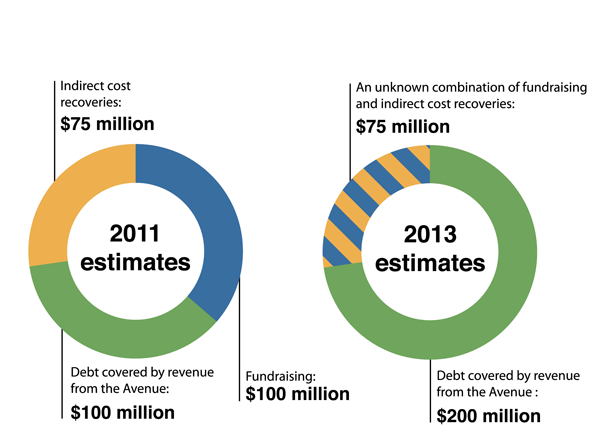Low interest rates are easing the $275 million funding burden for the Science and Engineering Hall, allowing GW to rely less heavily on fundraising and government dollars to complete construction of its largest academic building.
The good financial news comes as GW struggles to lure donors to fund the building’s construction costs and as federal research dollars threaten to dry up – two key sources paying for the hall, slated to open in 2015.
Executive Vice President and Treasurer Lou Katz said revenue from its booming local real estate investment in The Avenue will cover more of the building’s costs as the University takes advantage of low interest rates to support a larger debt burden through this steady stream of revenue.
With the extra cash, Katz said there’s “no hesitation” that the University will reach the total cost of the building.
“The gap is much smaller now and we’re confident we’ll be able to fund it by those three sources,” Katz said.
Fundraising and federal subsidies for research space, known as indirect cost recoveries, will fund just 27 percent of the $275 million Science and Engineering Hall, instead of the 63 percent initially planned. The University will cut the amount it needs to fundraise for construction by a quarter.
University President Steven Knapp called the decreased reliance on funding a “positive tradeoff.”
“In one sense, yes, I would say that if any one of those three legs improves, you have less dependence on the others, so that takes off some of the pressure. But that won’t mean we’ll take off the pressure,” Knapp said.
The University has accumulated a $1.4 billion debt load to pay for its bevy of capital projects, pushing its borrowing past its $1.3 billion endowment.
In March 2012, GW took on the single largest debt load in its history, raising total borrowing to two and a half times where it stood a decade ago as administrators try to quickly build up the University’s research potential and academic stature.
In February, Standard & Poor’s cautioned that GW could lose its top notch credit rating because of a decreasing operating margin partly brought on by that debt.
The fundraising office has raised $7 million for the science building’s construction costs out of the initial $100 million target by fiscal year 2022.
Vice President for Development and Alumni Relations Mike Morsberger said the office will still look to raise $100 million, of which at least the last quarter will go toward academic programs and research institutes.
Instead of paying directly for the building’s hefty construction, most donors – like construction mogul A. James Clark – have opted to fund large scholarship programs and pay for academic and research programs that the building will house.
“Even though the fundraising has been slower on the building itself, on the program that goes in the building, it’s been very successful so far. The program investments are clearly just as important, if not more important, than the building itself,” Katz said.







